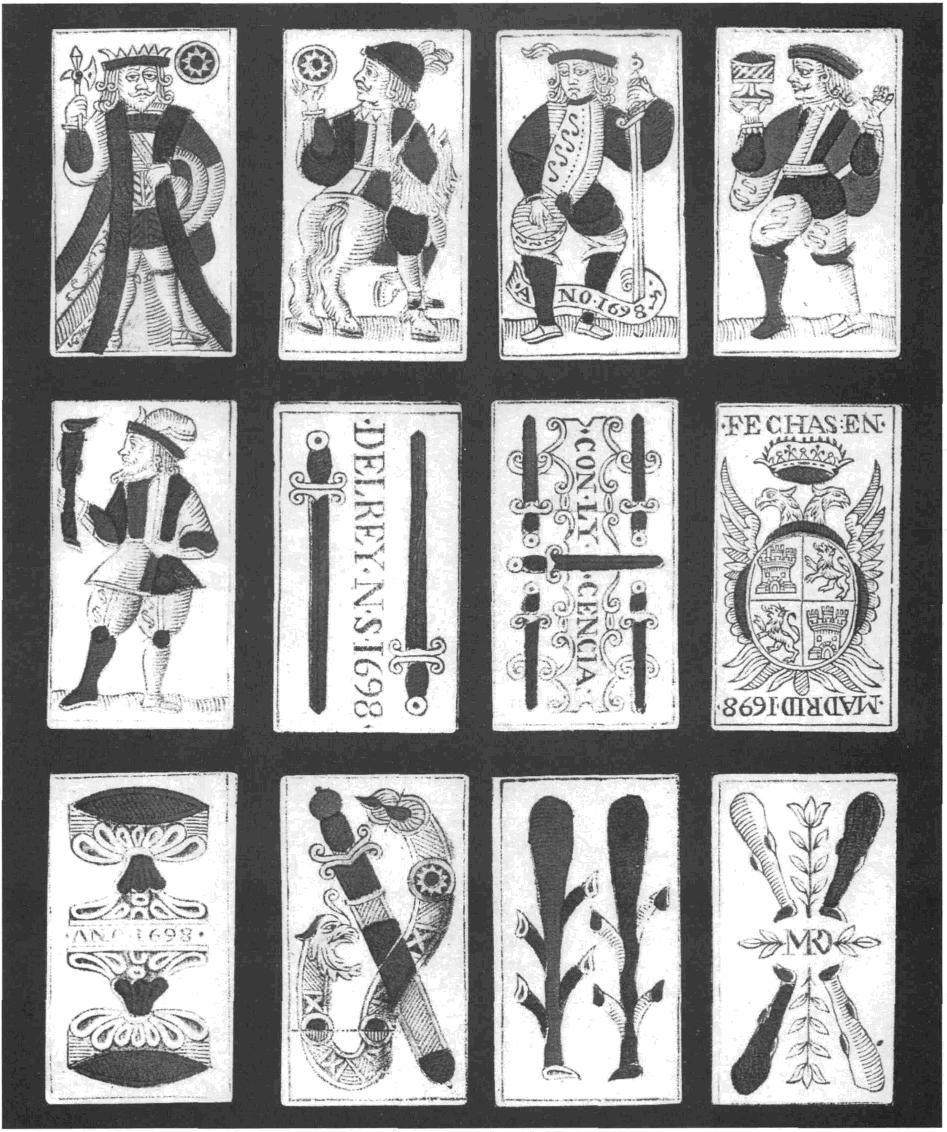

| Suit System: | S |
| Recommended Name: | the Madrid pattern. |
The alternative name the Castilian pattern has also been documented, but as it has already been used for a quite different pattern (the Fournier house pattern - see Pattern sheet S-6), it is better to use "Madrid pattern".
The following historical background is relevant to both the Madrid and Seville patterns and is therefore repeated in both pattern sheets.
The Kingdom of Spain was formed in 1496 only, when the King of Aragon (i.e. modern Aragon, Catalonia and Valencia) married the Queen of Castile (which comprised Andalusia as well as the Castiles). Subsequently, Charles V (I of Spain) and his successors reigned over a patchwork of entities where they were represented by viceroys. This was also true of Spanish overseas territories like Naples, Sicily and the Americas. In fact the King of Spain directly reigned only in Castile. This is why it was in this kingdom that playing-cards were taxed for the first time in European history: in 1543 Charles granted to a banker a monopoly (estanco) on the distribution of playing-cards, and later in the l6th Century the caption "con licencia del rey N[uestro] S[eñor]" (by permission of the King our Lord) was printed on some cards.
The image we have today of early Spanish playing-cards is very incomplete. However, a systematic examination of a large corpus of early Spanish cards housed in public and private collections shows at least two consistent patterns. This is confirmed by literary evidence, namely Francisco de Luque Fajardo: Fiel desengaño contra la ociosidad y los juegos (Madrid, 1603), who differentiated between "naipes de Castilla" and cards "en estampa de Andalucia".
The cards of Castile often bear the inscription "fechas en Madrid" (made in Madrid) whereas the cards from Andalusia generally bear "fechas en Sevilla". Cards of Castile are here called "Madrid pattern".
The main combination of features of the Madrid pattern (some shared with other patterns) are: king of Coins wields an axe; cavalier of Coins is seen in three-quarters backview; jack of Swords carries a sword pointing downwards, with one of his legs bent and a banderole between his legs; jack of Cups in profile holds a cup in front of him; jack of Batons in profile holds a staff upwards at arm's length; the inscription "con licencia del rey N.S." appears on 2 and 5 of Swords; the ace of Coins shows the arms of Castile and Leon with the caption "fechas en Madrid" and a date. There are no putti (muchachos). The dimensions are about 50 x 90mm.
The Madrid pattern seems to have evolved from an "early" Madrid Pattern, notable for its more elegant style, to a later and cruder Version. The earliest examples (all in the Museo "Fournier" de Naipes, Vitoria-Gasteiz) can be dated between the last third of the l6th Century and the early 17th Century. The "classic" Madrid pattern ranges between 1648 and 1739. Nevertheless, the pattern must have survived until c.1765, when the real Fabrica de Madrid adopted the old Catalan pattern now known as "National" (Pattern sheet No. S-1.1). The Madrid Pattern is clearly the prototype of the Sicilian pattern which is nothing but a cruder Version, sometimes with the motto "con licenza del re N.S." in Italian. The Neapolitan pattern has also retained some of its features.
The Madrid Pattern is known in 40- and 48-card packs, with king, cavalier, jack, plus ace to 9 or ace to 7.
Most of the cards or packs which have survived are anonymous. Although some of them were certainly made in Madrid, many packs were made abroad, mainly in France. Examples of the "early" Madrid pattern are known by Jehan Prou (Thiers, c.1567), Jehan Volay (Thiers, early 17th Century). We know that Spanish cards "façon Madrid" were produced in Marseilles in 1706; the cardmakers of the South-West of France (Bordeaux, Bayonne, Dax, Agen) made cards "petit Madrid" during the 18th Century.
ALFARO FOURNIER, Félix: Los Naipes (catalogue), Vitoria-Gasteiz, 1982.
DENNING, Trevor: Spanish Playing-Cards, Birmingham, 1980.
DEPAULIS, Thierry: Portraits en Espagne avant 1800, (IN) The Playing-Card, XX/3, 1992, pp.73-93.
DEPAULIS, Thierry: Portraits en Espagne (suite), (IN) The Playing-Card, XXI/4, 1993, pp.116-125.

| Anonymous cards, Madrid, 1698 (Temperley collection). |
| The International Playing-Card Society | 7/1995 ThD |